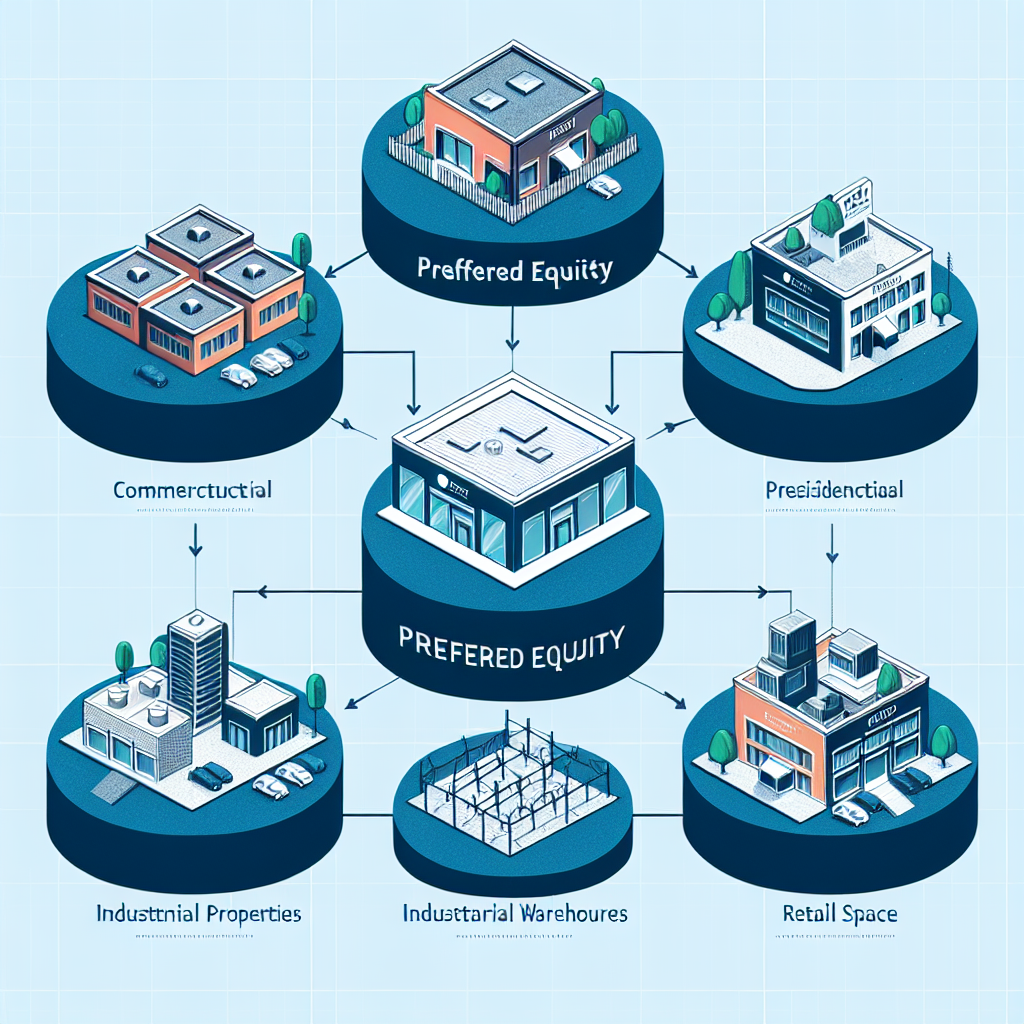-
Table of Contents
- Exploring Preferred Equity: Four Types of This Alternative Real Estate Asset Class
- Understanding Preferred Equity
- Types of Preferred Equity
- Traditional Preferred Equity
- Participating Preferred Equity
- Convertible Preferred Equity
- Perpetual Preferred Equity
- Case Studies and Examples
- Case Study 1: Traditional Preferred Equity in Multifamily Housing
- Case Study 2: Participating Preferred Equity in Hotel Renovation
- Case Study 3: Convertible Preferred Equity in Office Development
- Case Study 4: Perpetual Preferred Equity in Retail Property
- Statistics and Market Trends
- Conclusion
Exploring Preferred Equity: Four Types of This Alternative Real Estate Asset Class

In the dynamic world of real estate investment, preferred equity has emerged as a compelling alternative asset class. It offers a unique blend of debt and equity characteristics, providing investors with a hybrid investment vehicle that can yield attractive returns while mitigating some of the risks associated with traditional equity investments. This article delves into the intricacies of preferred equity, exploring its four primary types, and providing valuable insights through examples, case studies, and statistics.
Understanding Preferred Equity
Preferred equity is a form of investment in real estate that sits between senior debt and common equity in the capital stack. It provides investors with a fixed return, often in the form of dividends, and a higher claim on assets than common equity holders in the event of liquidation. However, unlike debt, preferred equity does not have a fixed maturity date and does not require regular interest payments.
Preferred equity is particularly attractive to investors seeking stable income with a lower risk profile compared to common equity. It also offers real estate developers and operators a flexible financing option that does not dilute ownership as much as common equity.
Types of Preferred Equity
Preferred equity can be categorized into four main types, each with its unique characteristics and benefits:
- Traditional Preferred Equity
- Participating Preferred Equity
- Convertible Preferred Equity
- Perpetual Preferred Equity
Traditional Preferred Equity
Traditional preferred equity is the most straightforward form of preferred equity. It provides investors with a fixed dividend, which is typically higher than the interest rates on senior debt but lower than the potential returns on common equity. This type of preferred equity is often used in stabilized properties where the cash flow is predictable.
For example, a real estate investment trust (REIT) might issue traditional preferred equity to finance the acquisition of a fully leased office building. Investors in this preferred equity would receive regular dividends, funded by the rental income from the tenants. In the event of liquidation, these investors would have a higher claim on the building’s assets than common equity holders but lower than senior debt holders.
Participating Preferred Equity
Participating preferred equity offers investors a fixed dividend along with a share of the property’s upside potential. This type of preferred equity is often used in value-add or opportunistic investments where there is significant potential for property appreciation.
For instance, a developer might use participating preferred equity to finance the renovation of an underperforming shopping center. Investors would receive a fixed dividend during the renovation period and a share of the profits once the property is stabilized and sold. This structure aligns the interests of the investors and the developer, as both parties benefit from the property’s success.
Convertible Preferred Equity
Convertible preferred equity provides investors with the option to convert their preferred shares into common equity at a predetermined conversion rate. This type of preferred equity is attractive to investors who want the potential for higher returns if the property performs well but also want the security of a fixed dividend.
A case study illustrating the use of convertible preferred equity is the financing of a mixed-use development project. The developer might issue convertible preferred equity to raise capital for the construction phase. Investors would receive a fixed dividend during construction and have the option to convert their shares into common equity once the project is completed and leased. This allows investors to participate in the property’s long-term appreciation while mitigating construction risk.
Perpetual Preferred Equity
Perpetual preferred equity does not have a maturity date, meaning it provides investors with a fixed dividend indefinitely. This type of preferred equity is often used in core real estate investments where the property is expected to generate stable cash flow over the long term.
For example, a REIT might issue perpetual preferred equity to finance the acquisition of a prime office building in a major city. Investors would receive regular dividends funded by the building’s rental income, with no obligation for the REIT to redeem the shares. This provides a stable income stream for investors and long-term capital for the REIT.
Case Studies and Examples
To better understand the practical applications of preferred equity, let’s explore a few real-world examples and case studies:
Case Study 1: Traditional Preferred Equity in Multifamily Housing
A real estate investment firm sought to acquire a stabilized multifamily property in a growing suburban market. To finance the acquisition, the firm issued traditional preferred equity, offering investors a fixed 7% annual dividend. The property’s consistent rental income provided a reliable source of funds for the dividends, making it an attractive investment for income-focused investors.
The firm successfully acquired the property and maintained high occupancy rates, ensuring steady cash flow. Investors received their fixed dividends as promised, and the firm retained control of the property without significant dilution of ownership.
Case Study 2: Participating Preferred Equity in Hotel Renovation
A developer planned to renovate an outdated hotel in a popular tourist destination. To fund the renovation, the developer issued participating preferred equity, offering investors a fixed 8% annual dividend during the renovation period and a 20% share of the profits upon sale.
The renovation was completed on time and within budget, and the hotel was repositioned as a boutique property with higher room rates. The developer sold the hotel at a significant profit, providing investors with both their fixed dividends and a substantial share of the profits. This structure incentivized the developer to maximize the property’s value, aligning their interests with those of the investors.
Case Study 3: Convertible Preferred Equity in Office Development
A developer sought to construct a new office building in a rapidly growing tech hub. To raise capital, the developer issued convertible preferred equity, offering investors a fixed 6% annual dividend during construction and the option to convert their shares into common equity upon completion.
The project was completed successfully, and the building quickly attracted high-profile tenants. Many investors chose to convert their preferred shares into common equity, benefiting from the property’s long-term appreciation. This structure provided investors with downside protection during construction and the potential for higher returns once the building was stabilized.
Case Study 4: Perpetual Preferred Equity in Retail Property
A REIT aimed to acquire a prime retail property in a major metropolitan area. To finance the acquisition, the REIT issued perpetual preferred equity, offering investors a fixed 5% annual dividend. The property’s stable rental income from long-term leases with high-quality tenants provided a reliable source of funds for the dividends.
Investors received regular dividends, enjoying a stable income stream without the need for the REIT to redeem the shares. The REIT benefited from long-term capital, allowing it to focus on managing and enhancing the property’s value.
Statistics and Market Trends
Preferred equity has gained popularity in recent years, driven by several market trends and investor preferences:
- According to Preqin, the global preferred equity market has grown significantly, with assets under management (AUM) reaching over $200 billion in 2022.
- A survey by the National Association of Real Estate Investment Trusts (NAREIT) found that 45% of institutional investors consider preferred equity an attractive investment option due to its risk-return profile.
- Data from Real Capital Analytics shows that preferred equity transactions accounted for approximately 15% of total real estate capital market activity in 2021, up from 10% in 2018.
These statistics highlight the growing acceptance and utilization of preferred equity as a viable investment vehicle in the real estate market.
Conclusion
Preferred equity offers a versatile and attractive investment option for both investors and real estate developers. By understanding the four main types of preferred equity—traditional, participating, convertible, and perpetual—investors can tailor their investment strategies to align with their risk tolerance and return objectives. Real-world examples and case studies demonstrate the practical applications and benefits of preferred equity in various real estate scenarios.
As the real estate market continues to evolve, preferred equity is likely to play an increasingly important role in financing and investment strategies. Its unique blend of debt and equity characteristics provides a compelling alternative for those seeking stable income, downside protection, and potential upside participation. By staying informed about market trends and understanding the nuances of preferred equity, investors can make well-informed decisions and capitalize on the opportunities this asset class offers.








